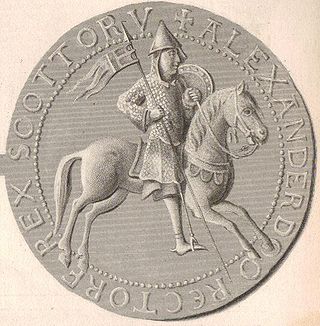
Alexander I, posthumously nicknamed The Fierce, was the King of Scotland from 1107 to his death. He succeeded his brother, King Edgar, and his successor was his brother David. He was married to Sybilla of Normandy, an illegitimate daughter of Henry I of England.
Lulach mac Gille Coemgáin was King of Alba (Scotland) between 15 August 1057 and 17 March 1058.
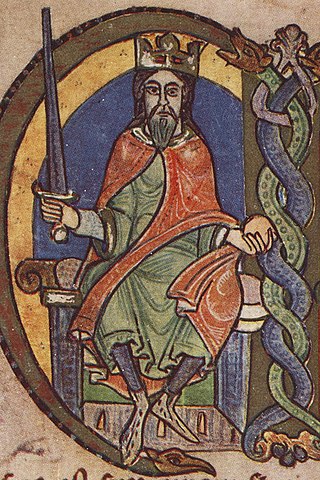
David I or Dauíd mac Maíl Choluim was a 12th-century ruler and saint who was Prince of the Cumbrians from 1113 to 1124 and later King of Scotland from 1124 to 1153. The youngest son of Malcolm III and Margaret of Wessex, David spent most of his childhood in Scotland, but was exiled to England temporarily in 1093. Perhaps after 1100, he became a dependent at the court of King Henry I of England, by whom he was influenced.

Malcolm IV, nicknamed Virgo, "the Maiden" was King of Scotland from 1153 until his death. He was the eldest son of Henry, Earl of Huntingdon and Northumbria and Ada de Warenne. The original Malcolm Canmore, a name now associated with his great-grandfather Malcolm III, he succeeded his grandfather David I, and shared David's Anglo-Norman tastes.

Cináed mac Maíl Coluim was King of Alba (Scotland) from 971 to 995. The son of Malcolm I, he succeeded King Cuilén on the latter's death at the hands of Rhydderch ap Dyfnwal in 971.

Dundrennan Abbey, in Dundrennan, Scotland, near to Kirkcudbright, was a Cistercian monastery in the Romanesque architectural style, established in 1142 by Fergus of Galloway, King David I of Scotland (1124–53), and monks from Rievaulx Abbey. Though extensively ruined, Dundrennan is noted for the purity and restraint of its architecture, reflecting the austere Cistercian ideal. It is also built from very hard-weathering grey sandstone, so the original architectural forms and mouldings are well preserved.
GilleAldan, of Whithorn, was a native Galwegian who was the first Bishop of the resurrected Bishopric of Whithorn or Galloway. He was the first to be consecrated by the Archbishop of York, who at that time was Thurstan. The re-creation of the Bishopric suited both the ruler of Galloway, Fergus, and the Archbishop, who had few suffragans and needed more in order to maintain his independence from Canterbury.

Fearchar of Ross or Ferchar mac in tSagairt, was the first of the Scottish Ó Beólláin family who received by Royal Grant the lands and Title of Mormaer or Earl of Ross (1223–1251) we know of from the thirteenth century, whose career brought Ross into the fold of the Scottish kings for the first time, and who is remembered as the founder of the Earldom of Ross.

The Kingdom of Alba was the Kingdom of Scotland between the deaths of Donald II in 900 and of Alexander III in 1286. The latter's death led indirectly to an invasion of Scotland by Edward I of England in 1296 and the First War of Scottish Independence.
William fitz Duncan was a Scottish prince, the son of King Duncan II of Scotland by his wife Ethelreda of Dunbar. He was a territorial magnate in northern Scotland and northern England and a military leader.

The High Middle Ages of Scotland encompass Scotland in the era between the death of Domnall II in 900 AD and the death of King Alexander III in 1286, which was an indirect cause of the Wars of Scottish Independence.
Christian of Whithorn was Bishop of Whithorn (1154–1186), the second incumbent of that Episcopal See since it had been resurrected by King Fergus of Galloway earlier in the 12th century.
The Meic Uilleim (MacWilliams) were the Gaelic descendants of William fitz Duncan, grandson of Máel Coluim mac Donnchada, king of Scots. They were excluded from the succession by the descendants of Máel Coluim's son David I during the 12th century and raised a number of rebellions to vindicate their claims to the Mormaerdom of Moray and perhaps to the rule of Scotland.
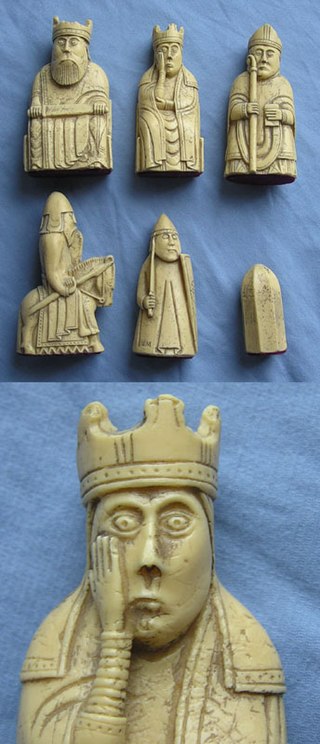
Harald Maddadsson was Earl of Orkney and Mormaer of Caithness from 1139 until 1206. He was the son of Matad, Mormaer of Atholl, and Margaret, daughter of Earl Haakon Paulsson of Orkney. Of mixed Norse and Gaelic blood, and a descendant of Scots kings, he was a significant figure in northern Scotland, and played a prominent part in Scottish politics of the twelfth century. The Orkneyinga Saga names him one of the three most powerful Earls of Orkney along with Sigurd Eysteinsson and Thorfinn Sigurdsson.

Political and military events in Scotland during the reign of David I are the events which took place in Scotland during David I of Scotland's reign as King of Scots, from 1124 to 1153. When his brother Alexander I of Scotland died in 1124, David chose, with the backing of Henry I of England, to take the Kingdom of Alba for himself. David was forced to engage in warfare against his rival and nephew, Máel Coluim mac Alaxandair. Subduing the latter took David ten years, and involved the destruction of Óengus, mormaer of Moray. David's victory allowed him to expand his control over more distant regions theoretically part of the Kingdom. In this he was largely successful, although he failed to bring the Earldom of Orkney into his kingdom.
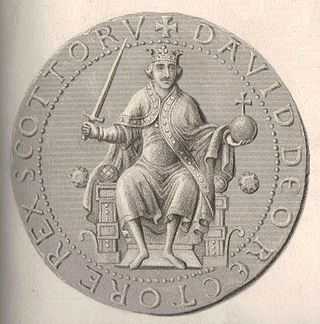
The Davidian Revolution is a name given by many scholars to the changes which took place in the Kingdom of Scotland during the reign of David I (1124–1153). These included his foundation of burghs, implementation of the ideals of Gregorian Reform, foundation of monasteries, Normanisation of the Scottish government, and the introduction of feudalism through immigrant Norman and Anglo-Norman knights.

Historical treatment of David I and the Scottish church usually emphasises King David I of Scotland's pioneering role as the instrument of diocesan reorganisation and Norman penetration, beginning with the bishopric of Glasgow while David was Prince of the Cumbrians, and continuing further north after David acceded to the throne of Scotland. As well as this and his monastic patronage, focus too is usually given to his role as the defender of the Scottish church's independence from claims of overlordship by the Archbishop of York and the Archbishop of Canterbury.

Gilbert was a 13th-century Cistercian monk, abbot and bishop. His first appearance in the sources occurs under the year 1233, for which year the Chronicle of Melrose reported that "Sir Gilbert, the abbot of Glenluce, resigned his office, in the chapter of Melrose; and there he made his profession". It is not clear why Gilbert really did resign the position of Abbot of Glenluce, head of Glenluce Abbey in Galloway, in order to become a mere brother at Melrose Abbey; nor is it clear for how long Gilbert had been abbot, though his latest known predecessor is attested last on 27 May 1222. After going to there, Gilbert became the Master of the Novices at Melrose.
Heathored of Whithorn is sometimes given as the Northumbrian Bishop of Whithorn, following the demise of Bishop Beadwulf. He is possibly the last known Anglo-Saxon Bishop of Whithorn. His name occurs for the last time around 833; no other bishop at Whithorn is known until the accession around three centuries later of Gille Aldan. It is sometimes thought that he may be the same man as Bishop Heathored of Lindisfarne.
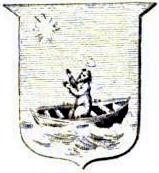
The Diocese of the Isles, also known as the Diocese of Suðreyar, or the Diocese of Sodor, was one of the dioceses of medieval Norway. After the mid-13th-century Treaty of Perth, the diocese was accounted as one of the 13 dioceses of Scotland. The original seat of the bishopric appears to have been at Peel, on St Patrick's Isle, where indeed it continued to be under English overlordship; the Bishopric of the Isles as it was after the split was relocated to the north, firstly to Snizort and then Iona.












